#Catholic History
Text
Time Travel Question 40: Medievalish and Earlier 7
These Questions are the result of suggestions from the previous iteration.
This category may include suggestions made too late to fall into the correct earlier time grouping, hence the occasional random item waaay out of it's time period.
In some cases a culture lasted a really long time and I grouped them by whether it was likely the later or earlier grouping made the most sense with the information I had. (Invention ofs tend to fall in an earlier grouping if it's still open. Ones that imply height of or just before something tend to get grouped later, but not always. Sometimes I'll split two different things from the same culture into different polls because they involve separate research goals or the like).
Please add new suggestions below if you have them for future consideration. All cultures and time periods welcome.
#Time Travel#Cathars#Middle Ages#Catholic History#Dominicans#Lalibela#Ethiopian History#Kyiv#Ukrainian History#Suzhou#Chinese History#The Sena Dynasty#Bengal#Indian History#Vlad Țepeș#Makapansgat Pebble#Homins#Ramban#Nachmanides#Jewish History#Genghis Khan#Mongolian Empire
119 notes
·
View notes
Text
A brief comparison of the liturgical prayers of the TLM (traditional Latin Mass) and the Novus Ordo.
Most practicing Catholics know that major revisions were made to Roman Catholic Mass in 1969, but aside from the language of the liturgy, what has changed?
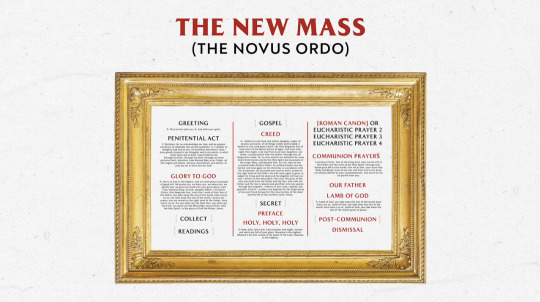
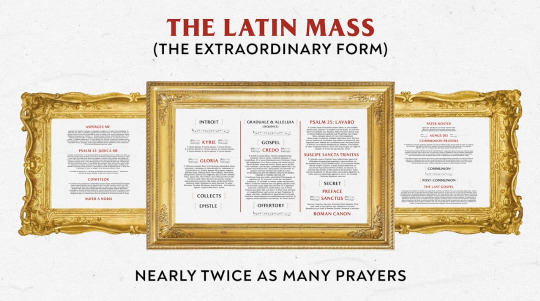
The Latin Mass has nearly twice as many prayers as the New Mass.
Orations
Of all the rotating prayers (orations) 83% are unique to the TLM. In the new missal, 669 of the original 1,273 orations have been removed, and of the remaining, only 13% were left unchanged.

Reverence
Even the number of times the priest kisses the altar, genuflects, and makes the sign of the cross, has been severely reduced
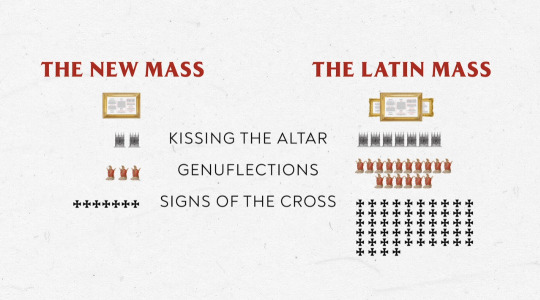
A Different Cycle of Scripture Readings
The new Roman missal has a three year cycle - a well intentioned attempt to expose the laity to more scripture in the Mass. However given the nature of the three year cycle, it's inevitable that the readings will not align as appropriately and succinctly as the specially chosen readings of the older one year cycle when it comes to specific feasts and the liturgical seasons, a choice of quantity over quality unfortunately.
I leave it to the reader to decide for his or herself whether the older one year or newer three year cycle is preferable.
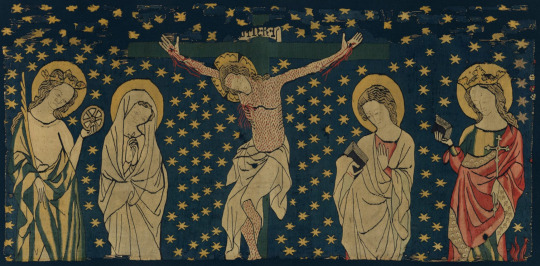
The Last Gospel
Catholics who have never attended a Latin Mass may be surprised to learn that following communion and dismissal, there is a lengthy gospel reading called The Last Gospel (John 1:1-14).
Why the last Gospel?
From the notations of the 1962 Roman Daily Missal:
The Mass began with the longing cry of the Old Testament: "Send forth Thy light and Thy truth!" It could not be concluded in a more worthy and more sublime manner than with the words of St. John: "The Word was made flesh, and dwelt among us; and we saw His glory as of the Only-Begotten of the Father, full of grace and truth."
And according to Catholic author Msgr. George J. Moorman, in his book, The Latin Mass Explained:
This reading, in the course of time, was added to the Eucharistic service on account of the great reverence the early Christians entertained for this portion of the Gospel and because it contains a summary of the benefits of which we are made partakers through Christ’s Sacrifice. The service was introduced by the prayer of the priest: ‘Send forth Thy Light and Thy Truth!’ It could not be concluded in a more becoming manner than with the words, ‘AND THE WORD WAS MADE FLESH, and dwelt among us; and we saw His glory, the glory as of the Only-begotten of the Father, full of grace and truth.’ At the words ‘AND THE WORD WAS MADE FLESH’, the priest and the people kneel on one knee in token of adoration of the mystery of the Incarnation, which is expressed in these words, and to indicate that the Son of God came from Heaven to earth. When the priest has finished the reading of this Gospel, the server answers, ‘Deo Gratias’—‘Thanks Be To God.’ These are the last words of the Mass.
Unfortunately this beautiful gospel passage and it's place of honor have been completely removed in the New Mass, and it's omission may even (as a matter of personal opinion) have contributed to the enormous number of people who leave Mass early immediately following Holy Communion.
Conclusion
Dearest Reader, I have attempted to be objective and only present facts in the above, however it may be clear to those of you who are familiar with my blog, where my biases lay. I am a Latin Mass Catholic, I love the traditional liturgy and will never stop advocating for the timeless Mass of ages that has brought untold numbers of faithful to the Lord for over a millennia. However, I make no judgment on the faithful who prefer the New Mass, nor do I mean to suggest that the Novus Ordo is in any way invalid. I only ask that all consider the information I have compiled and do your own research, that you may come to your own well informed conclusions. God Love You!
If any have questions or further interest in the topic of the Traditional Latin Mass my DMs are open or you may send an 'ask', I will answer or redirect you to the best of my ability.
(Credit to The Mass of the Ages project for images above)
111 notes
·
View notes
Text
On This Day In History
October 16th, 1384: Jadwiga is crowned King of Poland. Her older sister, Maria was also a woman king--Maria was king of Hungary and Croatia, though she had little official power. Jadwiga, however, was an incredibly effective ruler, and she remains one of the greatest rulers in Polish history.
162 notes
·
View notes
Text

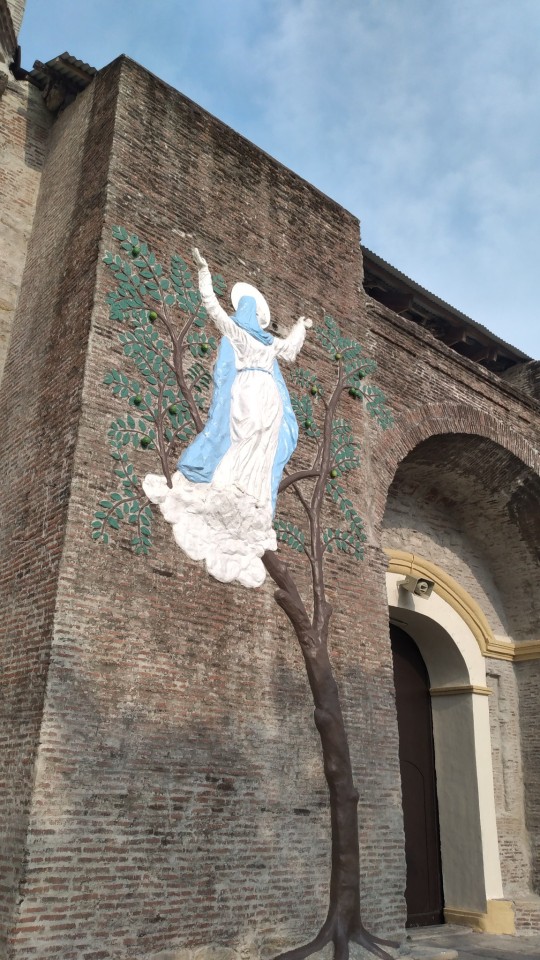
Nuestra Señora de la Asunción, Ilocos Sur, Philippines
#i should post more of my church pics lmao i visited so many last may#philippines#my post#philippine history#church history#catholic history#pilipinas
21 notes
·
View notes
Text


canon law vs. n*zi law
horrifying.
8 notes
·
View notes
Text
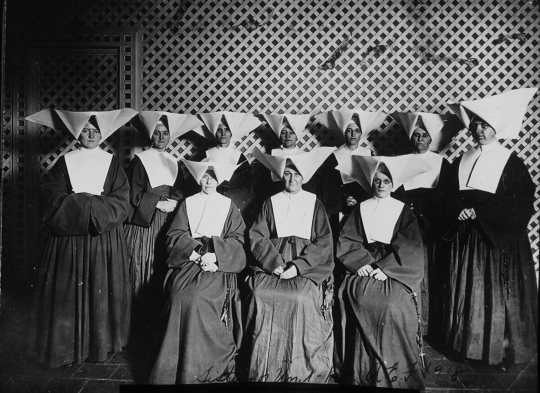


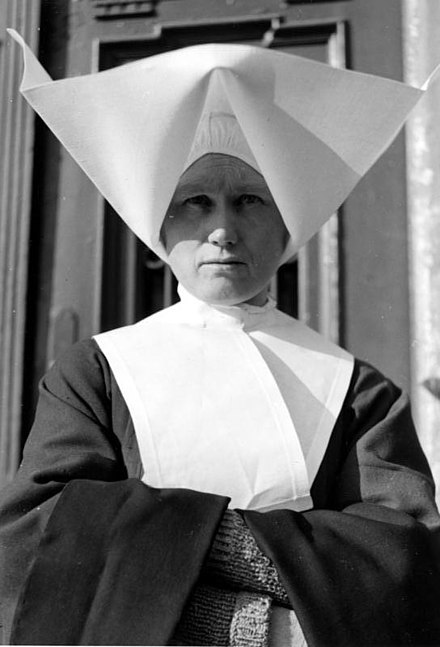


Various members of The Daughters of Charity, a society of apostolic life, wearing their distinctive cornette wimples.
The cornette was popular among Parisian women up until the early 19th century, and consisted of a starched white cloth that was folded upwards to resemble horns. When the Daughters of Charity was founded by St. Vincent De Paul in the 17th century, he wanted the sisters to resemble ordinary middle-class women as much as possible to allow them blend in while leaving their cloister to attend to the sick and poor. The distinctive wimple meant that members of the Daughters of Charity were known as 'butterfly nuns' or 'flying nuns' among the public.
However, the cornette was so heavy that it often caused injury or accidents, and took so much time to launder that it opposed the values of poverty and simplicity that orders operate by. After Vatican II, the nun's habits were simplified to better suit their purpose.
#nuns#the daughters of charity#history#religious history#catholic history#fashion history#st vincent de paul
25 notes
·
View notes
Note
St Elizabeth Seton?
She's one of the greatest educators of our time as far as I'm concerned!
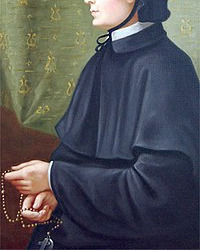
She was married and moved with her husband from Scotland to New York City in 1758, and they were heavily involved in the local Episcopal charities. They had five children and took in six more children after her brother-in-law died, at which point they moved to Maryland. Tragically her husband passed away in 1803, and in the mourning period, his Italian business partners introduced her to Catholicism. She converted in 1805, and recieved her first sacraments from John Carroll - the only Catholic bishop in the US and one of the signers of the declaration of independence.
To support herself and her kids after her husband's death she founded the first Catholic girl's school in the country, but when her conversion story spread, people withdrew their students. She was about to move to Canada, but was approached by a visiting priest who needed help. His order had fled the Reign of Terror in France which was in the midst of the revolution, and so she took them in as refugees on the school property and helped to establish the first US seminary. She founded another girl's school there, with the help of financial aid from Mount Saint Mary's University which is still an operating school today! She also established a religious order - the Sisters of Charity - who were dedicated to taking care of the children of the poor, and they started the first parochial catholic school system in the country. She was called Mother Seton and spent the rest of her life teaching and traveling.
She's the first canonized American Saint, by 1830, the Sisters of Mercy ran orphanages and schools from Cincinnati to New Orleans, and established the first hospital west of the Mississippi River, and as an extra kick, she's part of the National Women's Hall of Fame. I especially love her because she's semi-local to where I grew up, and as a homeschooled kid, she was the unofficial patron of our educational community too. If you go to Emmitsburg, Maryland, there's a beautiful Marian shrine with hiking trails that have the Stations of the Cross and Decades of the Rosary, and she has a beautiful basilica in her honor!

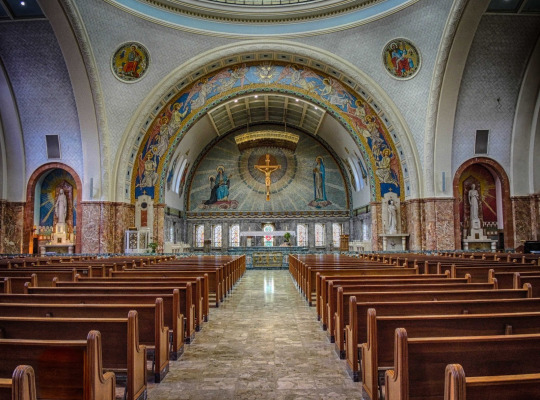

#catholic#st. elizabeth ann seaton#catholic history#christian#all saints day#all hallows ask game#all hallows eve
61 notes
·
View notes
Photo

#Catholic memes#Christian memes#meme#lord of the rings#lord of the rings meme#Catholic#Christian#Catholic tumblr#Christian tumblr#Catholic history#Christian history#pope st. paul vi#Catholic saints#Christblr#Cathblr#cast it into the fire#humanae vitae#isildur#elrond#lotr isildur#lotr elrond#hugo weaving#harry sinclair
170 notes
·
View notes
Text
slow inhale
Inverted crosses and crucifixes are not “iconic symbols of Satanism”!!!

The above image? 100% holy. Totally canonical. Has absolutely NOTHING to do with Satan, Lucifer, or “The Devil”. It’s called the Petrine Cross aka The Cross of Saint Peter and is a symbol of piety, humility, deference, and martyrdom particularly to Jesus Christ (not necessarily his other canonical phases of existence) and his relationship with the Pope. It’s also one of the symbols most closely associated with The Pope.
It is one of the main reasons I can’t take exorcist and demon-themed horror movies seriously ever. Not because I’m a polytheistic soul-selling Bandrui (those things are true but they’re not why), but because it’s a continuity error! A hilarious one if you think about it! The demon is just showing how much the characters really don’t understand about the religion they’re espousing in the movie!
So, why would St. Peter be associated with something that, for all intents and purposes, we visually associate with something that is backwards from Christianity or whatever “holiness” means? Because, like Jesus, St. Peter was also crucified, or at least that is the version of St. Peter’s story that is considered most canonical. In truth, stories about St. Peter that still exist date back only as late as 200 AD with the apocryphal “Acts of Peter”. Whether or not the upside down part of the story was canonical hasn’t been determined with any real certainty, but it was the version told by this guy:

Origen of Alexandria! Origen was largely considered one of the greatest early Christian luminaries, scholars, philosophers, poets, and all-around book nerds and is the primary source for the whole “St. Peter was crucified upside down” story, inspiring Renaissance masterworks like this little number by Caravaggio:

“Crucifixion Of Saint Peter”
Origen’s popularized telling of the tragic demise of St. Peter makes a big deal about the story-canonical feature that St. Peter insisted upon being crucified upside-down because he didn’t feel worthy to emulate the same, now-iconic crucifixion of Jesus.
So how did the Petrine Cross become a symbol associated with Satanism?
France.
Well, not all of it, but France was involved. In the early 19th century, a cult leader by the name of Eugène Vintras insisted that he was the reincarnation of the Prophet Elijah. Aside from that, he also practiced necromancy (which is the art of cavorting with DEMONS, not corpses for the love of my blackened, shriveled occultist heart) and was commonly seen wearing robes and symbols depicting the Petrine Cross.
In comes This Guy:
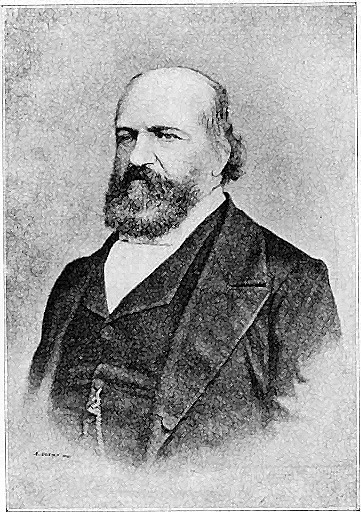
Éliphas Lévi was another famous 19th century French Occultist (after leaving the Catholic priesthood when he was in his 20′s to get drunk and listen to metal or something) who took one look at, and presumably all surviving sketches of Eugène Vintras, saw his regalia of Petrine crosses, and wrote the literally-damning words that for wearing his inverted crosses, Vintras’ satanic leanings were obvious.
After Éliphas Lévi wrote about Vintras’ wearing of the Petrine Cross and Satanic preferences, the inverted cross gradually became more and more associated with anti-religion movements and, of course, Satanism. The final nail in the Apocryphal Iconography Crucifixion came in the 1960′s-1980′s with the dawn of the horror movie franchise and the rise of the Satanic Panic, a mass hysteria movement that had to be debunked by the FBI where young people and children were convinced by their therapists during hypnotherapy sessions that they had been the subjects of Satanic rituals at the hands of the parents/guardians at very young ages that never happened, destroyed families, left countless people traumatized. FBI agent Kenneth Lanning went on to publish what’s commonly referred to as “The Lanning Report” to debunk the claims of abuse and lambast the therapist that started the panic in the first place.
If you want to really rock like a Satanist, consider donating stuff like feminine hygiene products to your local Planned Parenthood ;)

#inverted cross#petrine cross#catholic history#occult history#satanic panic#occultism#catholicism#satanism#menstruatin with satan
53 notes
·
View notes
Text

German Catholic stigmatic and mystic, Therese Neumann, 1926
After her miraculous (supposed) recovery from blindness and paralysis caused by a fall, Neumann developed the first signs of stigmata—a phenomenon in Catholicism in which a person thought to be chosen by god develops holy wounds (bleeding from the hands, feet, and side, akin to the wounds Jesus Christ suffered during his crucifixion, whip marks on the back, and/or bleeding from the head where the crown of thorns rested). Over the course of 8 months, she would develop every sign of stigmata including: 9 wounds on her head, marks along her back and shoulders, and wounds on her hands, feet, and sides, all of which according to family and friends did not heal nor get infected and were even found on her body after her death, almost 40 years later. Throughout this time, she would also report a plethora of visions, and refused to eat or drink anything apart from the Holy Eucharist, something which she allegedly continued up until she died in 1962.
61 notes
·
View notes
Text


Setons Shrine in Maryland
A year later I visited West Maryland, learning about the history of Setons Shrine. A church and museum, with a big history. Proud to say that I have been in North, Center, South, east, and west Maryland. I know Maryland have so much for me to discover it and I am all for it.
#setons shrine#church#Photographers on tumblr#history#east coast#travel photography#vacations#historic towns#historic church#shrine#church history#catholic history#Maryland#Frederick#Frederick maryland
5 notes
·
View notes
Photo




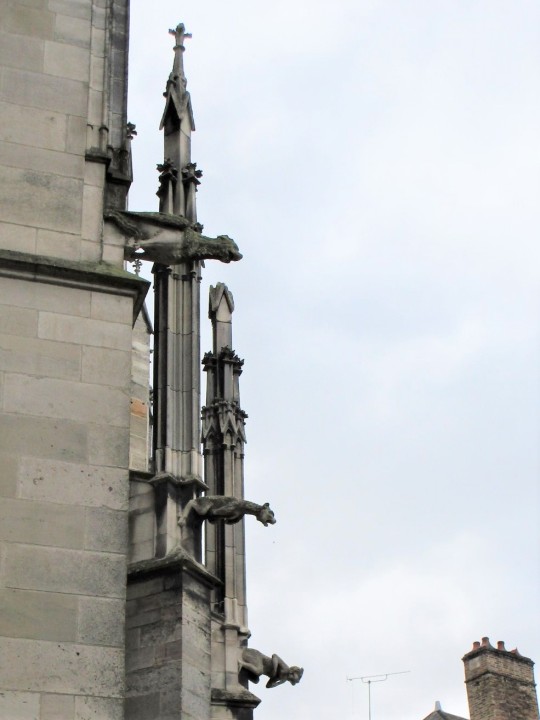
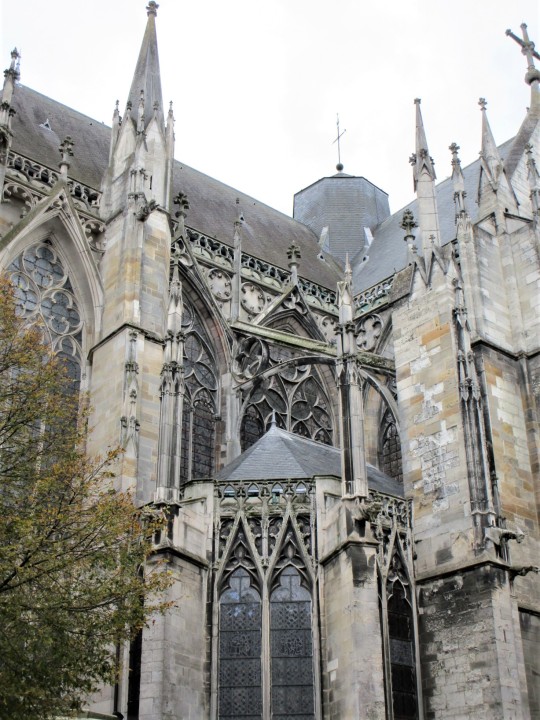


The Basilique Saint-Urbain de Troyes is a classic example of late 13th century French Gothic architecture. The perforated gables with sharp points, narrow buttresses with many pinnacles, and openwork flying buttresses combine to create a visually complex exterior. It has a wonderful collection of gargoyles I featured in previous posts here and here.
There is a great story about its construction that provides some insight into the Catholic church at the time. In 1262 it was endowed as a collegiate church by Pope Urban IV in honor of his patron saint. A collegiate church is under the jurisdiction of the Pope, not the local diocese. The nearby nuns’ Abbey of Notre Dame aux Nonnains was led by a woman named Ode de Pougy, a well-connected and privileged person in Troyes. She saw the new church as a serious threat to her power.
When the unfinished church was about to be consecrated in 1266, the abbess sent a gang to the site to destroy as much as possible. Doors were broken off, the high altar and capitals broken, the columns vandalized, and the carpenters' tools and materials confiscated. New doors were installed, which were also broken and removed soon after. A few months later a suspicious fire broke out that destroyed the wooden parts of the walls and the roof.
In 1268, Pope Clement IV sent an archbishop to consecrate the church and the nearby cemetery. Ode de Pougy hired armed men to prevent the archbishop from blessing the cemetery. The angry abbess then went to the church with her nuns, household staff and twenty-eight devoted followers and violently disrupted the archbishop’s attempt to consecrate the church. They drove him out of the church and into the road. When the Pope heard of the scandal, he launched an investigation, and in March of 1269 he excommunicated Ode de Pougy and several associates who had assisted her.
One hardly ever hears a story about a gang of territorial nuns vandalizing a church. I treasure this.
Photos by Charles Reeza
#Gothic architecture#Troyes#France#angry violent nuns#trouble in the family#Catholic history#medieval church#Title of my book: The Abbess Kicks Ass
26 notes
·
View notes
Text

Ecce Homo | the Man (1930) by Elías García Martínez after botched restoration attempt by Cecilia Giménez in 2012.
54 notes
·
View notes
Text

Geometric Ceiling Art as seen at Peterborough Cathedral, the final resting place of Katharine of Aragon.
5 notes
·
View notes
Text
Happy 248th Birthday to the US Navy!
The bravery of four Catholic chaplains in the line of duty has been recognized by US Navy vessels named in their honor:
Father Aloysius H. Schmitt and the USS Schmitt

Aloysius H. Schmitt was born in St. Lucas,Iowa on December 4, 1909, and was appointed acting chaplain with the rank of Lieutenant (Junior Grade) on June 28, 1939. Serving on his first sea tour, he was hearing confessions on board the battleship USS Oklahoma when the Japanese attacked Pearl Harbor on December 7, 1941. When the ship capsized, he was entrapped along with several other members of the crew in a compartment where only a small porthole provided a means of escape. He assisted others through the porthole, giving up his own chance to escape, so that more men might be rescued. He received the Navy and Marine Corps Medal posthumously for his courage and self-sacrifice. St. Francis Xavier Chapel, erected at Camp Lejeune in 1942, was dedicated in his memory.
The destroyer escort USS SCHMITT was laid down on February 22, 1943, launched on May 29, 1943, and was commissioned on July 24, 1943. The USS Schmitt was decommissioned and placed in reserve on June 28,1949 and struck from the Navy list on May 1,1967.
Father Joseph T. O'Callahan and the USS O'Callahan

Joseph T. O'Callahan was born in Boston, Massachusetts on May 14, 1905. He received his training for the Roman Catholic priesthood at St. Andrews College, Poughkeepsie, New York and at Weston School of Theology, Cambridge, Massachusetts. Prior to his commissioning as a Navy chaplain on August 7, 1940, he was head of the mathematics department at Holy Cross College. His earlier duty stations included the Naval Air Station, Pensacola, Florida, the USS Ranger, and Naval Air Station, Hawaii.
Chaplain O'Callahan was the Senior Chaplain aboard the aircraft carrier USS Franklin when the Japanese attacked it off the coast of Kobe, Japan, on March 19, 1945. After the ship received at least two well-placed bomb hits, fuel and ammunition began exploding and fires were rampant. The final casualty count listed 341 dead, 431 missing and 300 wounded. Captain L.E. Gehres, commanding officer of the carrier, saw Chaplain O'Callahan manning a hose which laid water on bombs so they would not explode, throwing hot ammunition overboard, giving last rites of his church to the dying, organizing fire fighters, and performing other acts of courage. Captain Gehres exclaimed, "O'Callahan is the bravest man I've ever seen in my life."
Chaplain O'Callahan received the Purple Heart for wounds he sustained that day. He and three other heroes of the war were presented the Congressional Medal of Honor by President Harry S. Truman. He was the first chaplain of any of the armed services to be so honored. He was released from active duty 12 November 1946 to resume his teaching duties and died in 1964.
The destroyer escort USS O'Callahan was laid down on February 19, 1964 and launched on October 20, 1965. Chaplain O'Callahan's sister, Sister Rose Marie O'Callahan, was the sponsor, the first nun tosponsora U.S. Navy ship. The commissioning took place July 13, 1968, at the Naval Shipyard in Boston, Massachusetts. The USS O'Callahan had its shakedown cruise out of San Diego and later operated largely in anti-submarine training and reconnaissance in the Western Pacific. In 1982-83, the ship had an eight-month deployment in the Indian Ocean. The USS O'Callahan was decommissioned on December 20,1988.
Father Vincent R. Capodanno and the USS Capodanno

Vincent R. Capodanno was born in Richmond County, New York, on February 13, 1929. He was an avid swimmer and a great sports enthusiast. After receiving his training at Fordham University in New York City, Maryknoll Seminary College in Glen Ellyn, Illinois, and Maryknoll Seminaries in Bedford, Massachusetts and New York City, New York, he was ordained on June 7, 1957 by Francis Cardinal Spellman, Archbishop of New York and Military Vicar of the Roman Catholic Military Ordinariate. Shortly thereafter, he began an eight-year period of service in Taiwan and Hong Kong under the auspices of the Catholic Foreign Mission Society.
Chaplain Capodanno received his commission with the rank of Lieutenant on December 28, 1965. Having requested duty with Marines in Vietnam, he joined the First Marine Division in 1966 as a battalion chaplain. He extended his one-year tour by six months in order to continue his work with the men. While seeking to aid a wounded corpsman, he was fatally wounded on September 4, 1967 by enemy sniper fire in the Quang Tin Province. He was posthumously awarded the Medal of Honor "for conspicuous gallantry and intrepidity at risk of his life above and beyond the call of duty...." He had previously been awarded the Bronze Star Medal for bravery under battle conditions.
The destroyer escort USS Capodanno keel was laid down on February 25, 1972; the ship was christened and launched on October 21, 1972 and commissioned on November 17, 1973. The USS Capodanno was designed for optimum performance in anti-submarine warfare. Deployments included operations in the Western Atlantic, West Africa, the Mediterranean, and South America. The USS Capodanno was decommissioned on July 30, 1993.
Father John Francis Laboon, SJ and the USS Laboon

John Francis Laboon, Jr., a Pittsburgh, Pennsylvania, native, born April 11, 1921, was a member of the Class of 1944 at the U.S. Naval Academy and a distinguished athlete. In World War II, Ensign Laboon was awarded the Silver Star for bravery for diving from his submarine, the USS PETO, to rescue a downed aviator while under heavy fire. Lieutenant Laboon left the Navy after the war to enter the Jesuits. With the Navy never far from his thoughts, he returned to his beloved "blue and gold" as a chaplain in 1958. For the next twenty-one years, he served the Navy-Marine Corps team in virtually every community and location including tours in Alaska, Hawaii, Japan, and Vietnam, where he received the Legion of Merit with Combat "V" for his fearless action as battlefield chaplain. He was the first chaplain assigned to a Polaris Submarine Squadron and Senior Catholic Chaplain at the Naval Academy. Captain Laboon retired in in 1979 as Fleet Chaplain, U.S. Atlantic Fleet and died in 1988.
The launching of the guided missile destroyer Laboon nicknamed the "Fearless 58" took place on February 20, 1993, at Bath Iron Works. The highlight of the event was the presence of the honoree's three sisters and brother. Christening the ship were sisters De Lellis, Rosemary, and Joan, all members of the Sisters of Mercy. Rev. Joseph D. Laboon of the V.A. Medical Center of New Orleans offered the invocation. Former Chief of Navy Chaplains and the then-current Archbishop of New York, Cardinal John O'Connor, offered remarks. The commissioning of the USS Laboon took place on March 18,1995 in Norfolk, VA.
Throughout a lifetime of service to God and Country, Chaplain Laboon was an extraordinary example of dedication to Sailors and Marines everywhere.
[all information from the USCCB website]
#catholic#catholic history#us navy#us navy history#naval history#us navy birthday#military history#military ships
1 note
·
View note
Text


Zanobi Machiavelli
1418-1479
#machiavelli#zanobi machiavelli#religious art#catholic art#catholic history#roman catholic#blessed virgin mary#virgin mary#mary mother of god#hail mary#madonna and child#art#history#historical aesthetic#warm aesthetic#catholic aesthetic#coffee academia#art gallery#gallery art#art gallery aesthetic#traditional catholic#cozy aesthetic#art academia#art aesthetic#classical art#classical aesthetic#classical academia#dark acadamia aesthetic#dark acamedia#dark academism
23 notes
·
View notes